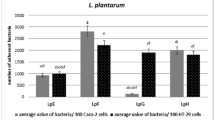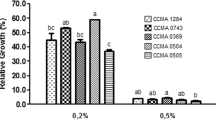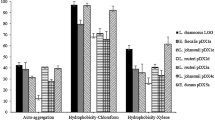Abstract
Autoaggregation has been correlated with adhesion, which is known to be a prerequisite for colonization and infection of the gastrointestinal tract by many pathogens. The coaggregation properties of probiotic strains with pathogens as well as their ability to displace pathogens are of importance for therapeutic manipulation of the aberrant intestinal microbiota. Consequently, the ability to aggregate and coaggregate are desirable properties for probiotics in health-promoting foods. Aggregation assays and bacterial adhesion to hydrocarbons (BATH test) demonstrated significant differences in cell surface properties among the tested commercial probiotic strains. Hydrophobicity increased when the cells were heat-inactivated. All probiotic strains tested showed aggregation abilities with the pathogen strains tested, but the results were strain-specific and dependent on time and incubation conditions. Our results indicate that the ability to autoaggregate, together with cell-surface hydrophobicity and coaggregation abilities with pathogen strains can be used for preliminary screening in order to identify potentially probiotic bacteria suitable for human or animal use.


Similar content being viewed by others
References
FAO/WHO (2002) Guidelines for the evaluation of probiotics in food. Food and Agricultural Organization of the United Nations and World Health Organization. Working Group Report, 2002
Collins JK, Thornton G, Sullivan GO (1998) Int Dairy J 8:487–490
Ouwehand AC, Salminen S, Isolauri E (2002) Antonie van Leeuwenhoek 82:279–289
Forestier C, De Champs C, Vatoux C, Joly B (2001) Res Microbiol 152:167–173
Guandalini S (2006) J Clin Gastroenterol 40(3):244–248
Katz JA (2006) J Clin Gastroenterol 40(3):249–255
Fooks LJ, Fuller R, Gibson GR (1999) Int Dairy J 9:53–61
Collado MC, González A, González R, Hernández M, Ferrús MA, Sanz Y (2005) Int J Antimicrob Agents 25:385–391
Collado MC, Hernández M, Sanz Y (2005) J Food Prot 68:1034–1040
Gagnon M, Kheadr EE, Le Blay G, Fliss I (2004) Int J Food Microbiol 92:69–78
Servin AL (2004) FEMS Microbiol Rev 28:405–440
Freter M (1992) Factors affecting the microecology of the gut. In: Fuller R (ed) Probiotics. the scientific basis. Chapman and Hall, Glasgow, pp 111–145
Bibiloni R, Perez PF, Garrote GL, Disalvo EA, De Antoni GL (2001) Methods Enzymol 336:411–427
Canzi E, Guglielmetti S, Mora D, Tamagnini I, Parini C (2005) Antonie Van Leeuwenhoek 88(3–4):207–219
Boris S, Suarez JE, Barbes C (1997) J Appl Microbiol 83(4):413–420
Schachtsiek M, Hammes WP, Hertel C (2004) Appl Environ Microbiol 70(12):7078–7085
Rosenberg M, Gutnick D, Rosenberg M (1980) FEMS Microbiol Lett 9:29–33
Kos B, Suskovic J, Vukovic S, Simpraga M, Frece J, Matosic S (2003) J Appl Microbiol 94:981–987
Reniero R, Cocconcelli P, Bottazzi V, Morelli L (1992) J Gen Microbiol 138:763–768
Handley PS, Harty DW, Wyatt JE, Brown CR, Doran JP, Gibbs AC (1987) J Gen Microbiol 133(11):3207–3217
Malik A, Sakamoto M, Ono T, Kakii K (2003) J Biosci Bioeng 96:10–15
Del Re B, Sgorbati B, Miglioli M, Palenzona D (2000) Lett Appl Microbiol 31:438–442
Pelletier C, Bouley C, Cayuela C, Bouttier S, Bourlioux P, Bellon-Fontaine MN (1997) Appl Environ Microbiol 63:1725–1731
Perez PF, Minnaard Y, Disalvo EA, De Antoni GL (1998) Appl Environ Microbiol 64:21–26
Collado MC, Gueimonde M, Hernandez M, Sanz Y, Salminen S (2005) J Food Prot 68(12):2672–2678
Jankovic I, Ventura M, Meylan V, Rouvet M, Elli M, Zink R (2003) J Bacteriol 185:3288–3296
Vinderola CG, Medici M, Perdigón G (2004) J Appl Microbiol 96:230–243
Gomez Zavaglia A, Kociubinski G, Perez P, Disalvo E, De Antoni G (2002) J Appl Microbiol 93(5):794–799
Rojas M, Conway PL (1996) J Appl Bacteriol 81:474–480
Rickard AH, Gilbert P, High NJ, Kolenbrander PE, Handley PS (2003) Trends Microbiol 11:94–100
Spencer RJ, Chesson A (1994) TJ Appl Bacteriol 77:215–220
Cesena C, Morelli L, Alander M, Siljander T, Tuomola E, Salminen S, Mattila-Sandholm T, Vilpponen-Salmela T, Von Wright A (2001) J Dairy Sci 84:1001–1010
Acknowledgments
The authors gratefully acknowledge financial support from the Academy of Finland, Research Council for Biosciences and Environment (decision number 210309 to Åbo Akademi and 210310 to University of Turku). M.C. Collado is the recipient of Excellence Postdoctoral grant from Conselleria Empresa, Universidad y Ciencia de la Generalitat Valenciana, Spain (BPOSTDOC 06/016).
Author information
Authors and Affiliations
Corresponding author
Rights and permissions
About this article
Cite this article
Collado, M.C., Meriluoto, J. & Salminen, S. Adhesion and aggregation properties of probiotic and pathogen strains. Eur Food Res Technol 226, 1065–1073 (2008). https://doi.org/10.1007/s00217-007-0632-x
Received:
Revised:
Accepted:
Published:
Issue Date:
DOI: https://doi.org/10.1007/s00217-007-0632-x




